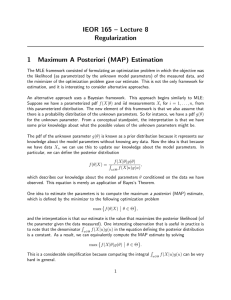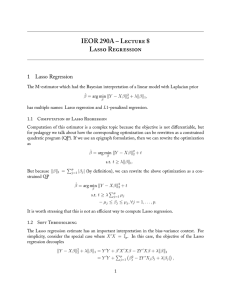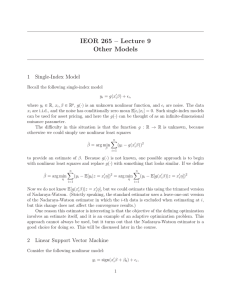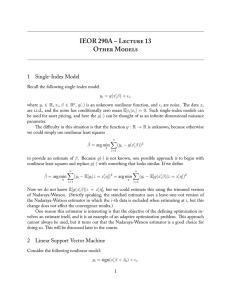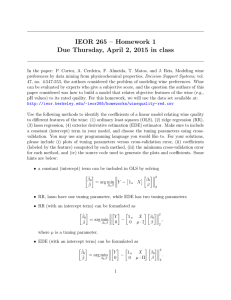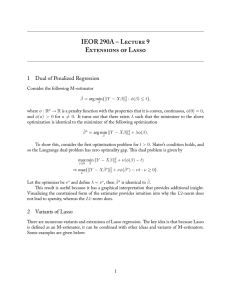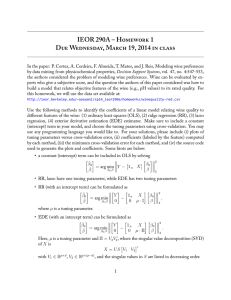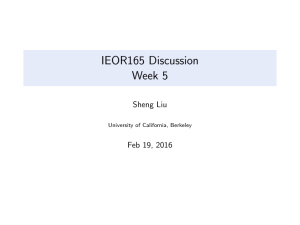IEOR 165 – Lecture 16 Regularization 1 Maximum A Posteriori (MAP) Estimation
advertisement
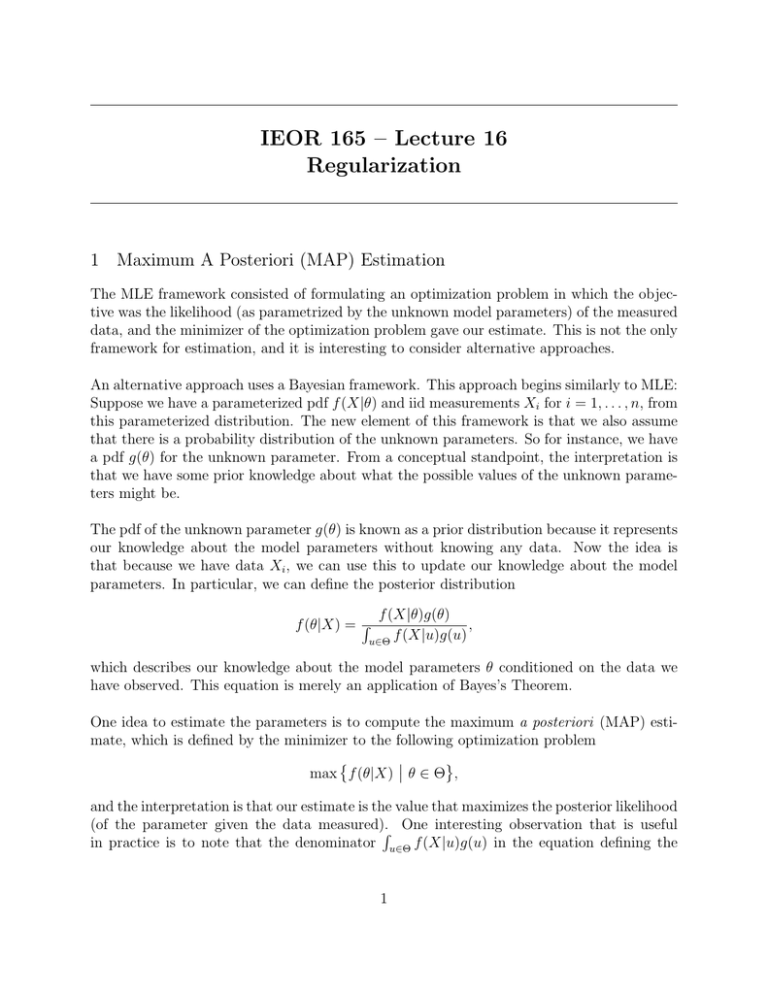
IEOR 165 – Lecture 16
Regularization
1 Maximum A Posteriori (MAP) Estimation
The MLE framework consisted of formulating an optimization problem in which the objective was the likelihood (as parametrized by the unknown model parameters) of the measured
data, and the minimizer of the optimization problem gave our estimate. This is not the only
framework for estimation, and it is interesting to consider alternative approaches.
An alternative approach uses a Bayesian framework. This approach begins similarly to MLE:
Suppose we have a parameterized pdf f (X|θ) and iid measurements Xi for i = 1, . . . , n, from
this parameterized distribution. The new element of this framework is that we also assume
that there is a probability distribution of the unknown parameters. So for instance, we have
a pdf g(θ) for the unknown parameter. From a conceptual standpoint, the interpretation is
that we have some prior knowledge about what the possible values of the unknown parameters might be.
The pdf of the unknown parameter g(θ) is known as a prior distribution because it represents
our knowledge about the model parameters without knowing any data. Now the idea is
that because we have data Xi , we can use this to update our knowledge about the model
parameters. In particular, we can define the posterior distribution
f (θ|X) = ∫
f (X|θ)g(θ)
,
f (X|u)g(u)
u∈Θ
which describes our knowledge about the model parameters θ conditioned on the data we
have observed. This equation is merely an application of Bayes’s Theorem.
One idea to estimate the parameters is to compute the maximum a posteriori (MAP) estimate, which is defined by the minimizer to the following optimization problem
{
}
max f (θ|X) θ ∈ Θ ,
and the interpretation is that our estimate is the value that maximizes the posterior likelihood
(of the parameter given the data measured).∫ One interesting observation that is useful
in practice is to note that the denominator u∈Θ f (X|u)g(u) in the equation defining the
1
posterior distribution is a constant. As a result, we can equivalently compute the MAP
estimate by solving
{
}
max f (X|θ)g(θ) θ ∈ Θ .
∫
This is a considerable simplification because computing the integral u∈Θ f (X|u)g(u) can be
very hard in general.
2 Regularization
Regularization is the process of purposely increasing the bias of an estimator so that the
overall estimation error decreases. There are different types of regularization that are available to us depending on what underlying structure may be present in the system that we are
trying to model. Incorporating appropriate regularization is arguably the most important
step in modeling, and the key problem is to understand what kinds of additional structure
can be imposed onto the model.
3 L2 Regularization
We have already seen the example of L2 regularization imposed on the OLS method:
β̂ = arg min ∥Y − Xβ∥22 + λ∥β∥22 .
As discussed in the previous lecture, this approach can be interpreted as providing (proportional) statistical shrinkage. This shrinks the estimated coefficients of the linear model
towards zero, in exchange for a reduction in variance of the estimated coefficients. However,
this is not the only interpretation of L2 regularization for the OLS model.
3.1
Bayesian Interpretation
This L2 regularization also has a Bayesian interpretation. We begin with the same linear
model
yi = x′i β + ϵi ,
where ϵi ∼ N (0, σ 2 ). And assume the prior distribution of the coefficients are iid Gaussians:
√
βj ∼ N (0, 1/ 2λ).
Then the MAP estimate is given by
( ∑n
) ∏p
(
)
′
2
2
2
β̂ = arg max exp
i=1 −(yi − xi β) /(2σ )
j=1 exp − λβj .
Using the same trick as in MLE, we instead minimize the negative logarithm:
∑
∑
β̂ = arg min ni=1 (yi − x′i β)2 /(2σ 2 ) + pj=1 λβj2 .
And this is the same as solving
β̂ = arg min ∥Y − Xβ∥22 + λ̃∥β∥22 ,
where λ̃ = 2λσ 2 .
2
3.2
Collinearity
Collinearity is an issue that frequently arises when trying to construct linear models from
data. Suppose we would like to build a linear model that has an output of mortality rate
and inputs of
• age
• salary
• blood pressure
• cholesterol level
• weight
• height
• body fat percentage
Constructing this model is more difficult than it might initially seem. The reason is that the
inputs are expected to display collinearity, meaning that the inputs themselves are correlated
to each other. For instance, body fat percentage will be correlated to weight and height.
Similarly, blood pressure will be correlated to age and weight.
It turns out that this kind of structure causes the estimation error of OLS to increase
significantly. The reasons are technical but can be interpreted either in the language of
differential geometry or in the context of numerical conditioning. Given the challenges faced
by such collinearity, it is interesting to consider how to improve estimation error of OLS.
One approach that works well in practice is to incorporate L2 regularization into OLS.
4 L1 Regularization
Another type of regularization is known as L1 regularization, and it consists of solving the
following optimization problem
β̂ = arg min ∥Y − Xβ∥22 + λ∥β∥1 ,
where λ is a tuning parameter. This approach is also called Lasso regression, and is a popular
technique in machine learning.
3
4.1
Soft Thresholding Interpretation
The Lasso regression estimate has an important interpretation
bias-variance context.
∑nin the
2
For simplicity, consider the one-dimensional case in which i=1 xi = 1. In this case, the
objective of the Lasso regression is
β̂ = arg min
= arg min
=
=
n
∑
i=1
n
∑
(yi − xi · β)2 + λ|β|
yi2 − 2yi xi β + x2i β 2 + λ|β|
i=1
∑
arg min( ni=1
∑
arg min( ni=1
∑
∑
−2yi xi )β + ( ni=1 x2i )β 2 + λ|β| + ni=1 yi2
∑
−2yi xi )β + β 2 + λ|β| + ni=1 yi2 .
Note that even though the objective is not differentiable, we can break the problem into
three cases. In the first case, β > 0 and so setting the derivative equal to zero gives
∑
∑
2β + ( ni=1 −2yi xi ) + λ = 0 ⇒ β̂ = ni=1 yi xi − λ/2.
In the second case, βj < 0 and so setting the derivative equal to zero gives
∑
∑
2β + ( ni=1 −2yi xi ) − λ = 0 ⇒ β̂ = ni=1 yi xi + λ/2.
In the third case, βj = 0.
For reference, we also compute the OLS solution in this special case. If we define β̂ 0∑
to be the
0
OLS solution, then a similar calculation to the one shown above gives that β̂ = ni=1 yi xi .
And so comparing to OLS solution to the Lasso regression solution, we have that
0
0
β̂ + λ/2, if β̂ = β̂ + λ/2 < 0
β̂ = β̂ 0 − λ/2, if β̂ = β̂ 0 − λ/2 > 0
0,
otherwise
This can be interpreted as a soft thresholding phenomenon, and it is another approach to
balancing the bias-variance tradeoff.
4.2
Dual Formulation
Consider the following optimization problem
β̂ = arg min{∥Y − Xβ∥22 : ϕ(β) ≤ t},
β
where ϕ : Rp → R is a penalty function with the properties that it is convex, continuous,
ϕ(0) = 0, and ϕ(u) > 0 for u ̸= 0. It turns out that there exists λ such that the minimizer
to the above optimization is identical to the minimizer of the following optimization
β̂ λ = arg min ∥Y − Xβ∥22 + λϕ(β).
β
4
This relationship can be established using duality theory from optimization, but that material is covered in other courses.
However, this result is useful because it has a graphical interpretation that provides additional insight. Visualizing the constrained form of the estimator provides intuition into why
L2 regularization does not lead to sparsity, whereas L1 regularization does. By sparsity, we
mean that most of the estimated linear coefficients β will be equal to zero. This is important
because zero coefficients indicate no relationship between the corresponding input variables
and the output variable. Furthermore, in many applications we can have an extremely large
number of inputs (several thousand inputs is not uncommon), and we may not know a priori
which inputs are relevant. The Lasso regression method is one approach that helps choose
relevant input variables, and is popular in machine learning for this reason.
4.3
Bayesian Interpretation
We begin with the same linear model
yi = x′i β + ϵi ,
where ϵi ∼ N (0, σ 2 ). And assume the prior distribution of the coefficients are iid Laplacians
with zero mean and scale parameter 1/λ. Recall that the pdf of this Laplacian distribution
is
(
)
1
f (u) =
exp − |u − µ|/b .
2b
Then the MAP estimate is given by
( ∑n
) ∏p
(
)
′
2
2
β̂ = arg max exp
i=1 −(yi − xi β) /(2σ )
j=1 exp − λ|βj | .
Using the same trick as in MLE, we instead minimize the negative logarithm:
∑
∑
β̂ = arg min ni=1 (yi − x′i β)2 /(2σ 2 ) + pj=1 λ|βj |.
And this is the same as solving
β̂ = arg min ∥Y − Xβ∥22 + λ̃∥β∥1 ,
where λ̃ = 2λσ 2 .
5 Elastic Net
In some situations, we might have collinearity of the input variables and a large number of
input variables. In these cases, we can combine L1 and L2 regularization and solve
β̂ = arg min ∥Y − Xβ∥22 + λ∥β∥22 + µ∥β∥1 .
This method is known as the elastic net.
5
